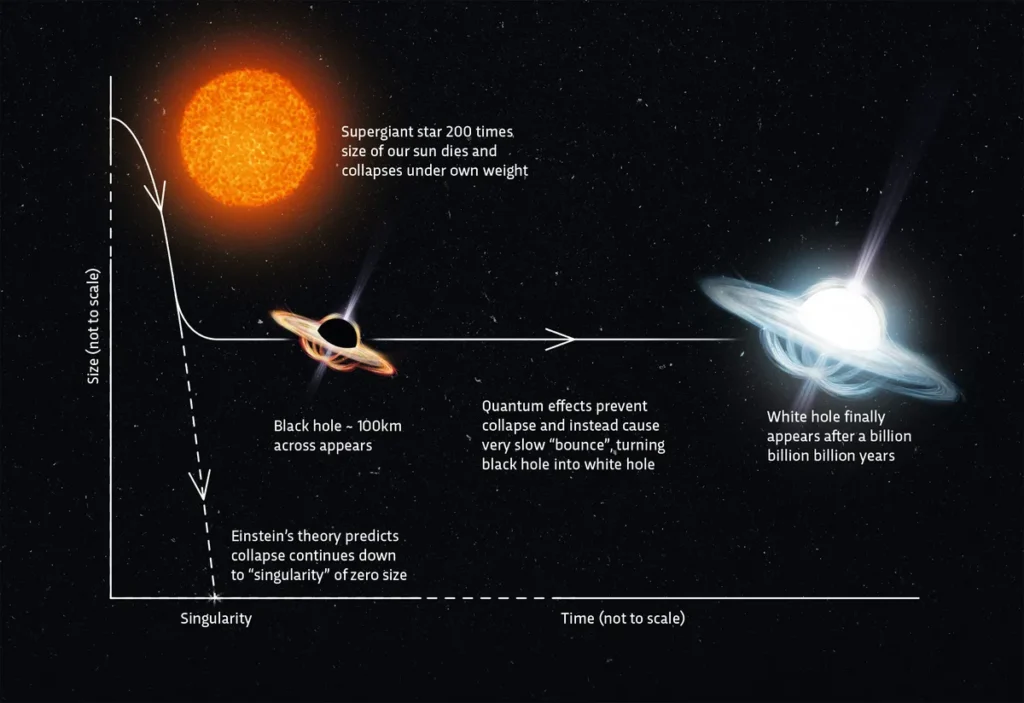In the vast expanse of the cosmos, black holes have long fascinated scientists and the public alike with their mysterious properties and intense gravitational pull. However, their theoretical counterparts, white holes, are equally intriguing, despite being less well-known and even more enigmatic. White holes, predicted by the same equations that describe black holes, are hypothetical regions in space that emit matter and energy rather than absorb it. White Holes, The Reverse of Black Holes, stands as a theoretical concept, spewing out matter and energy in contrast to their light-devouring counterparts. This blog delves into the concept of white holes, exploring their theoretical foundations, possible implications, and the ongoing quest to understand these cosmic phenomena.

What is a White Hole?
A theoretical concept in general relativity is called a white hole. In essence, it is a black hole in reverse. The event horizon of a white hole is a barrier that nothing can enter, whereas the event horizon of a black hole is a limit beyond which nothing can escape. A white hole is an intense producer of particles and radiation because it releases matter and energy. A white hole is a hypothetical region of spacetime that cannot be entered from the outside, but from which matter and light may escape. In essence, it’s the opposite of a black hole. While a black hole pulls everything in, a white hole pushes everything out.
Origin
- The possibility of white holes was first suggested by Soviet cosmologist Igor Novikov in 1964.
- While we haven’t observed physical processes leading to white hole formation, some theories propose that supermassive black holes could spawn supermassive white holes at the centers of galaxies.
Theoretical Foundations
The general relativity field equation solutions of Einstein give rise to the notion of white holes. In particular, a white hole area can be included in the Schwarzschild solution, which represents a non-rotating black hole. This extension results in the so-called maximally extended Schwarzschild metric, which is composed of a white hole and a black hole joined by an Einstein-Rosen bridge, a structure resembling a wormhole.
Key Characteristics of White Holes
Event Horizon: Similar to black holes, white holes have an event horizon. However, in the case of a white hole, the event horizon is a boundary that expels matter and radiation, rather than trapping them.
Time Reversal Symmetry: White holes can be thought of as the time-reversed counterparts of black holes. This means that while black holes evolve from a star collapsing, white holes would theoretically evolve backward, expelling matter and radiation.
Singularity: At the core of a white hole, there is a singularity, a point where the curvature of spacetime becomes infinite. However, unlike black holes, the singularity of a white hole is in the past rather than the future.
Potential Implications and Challenges
Existence and Detection: While black holes have been observed indirectly through their effects on nearby matter and through gravitational waves, white holes have not been detected. The lack of observational evidence raises questions about their existence.
Stability: Theoretical models suggest that white holes may be unstable. Any slight disturbance could collapse the white hole, making it a very transient phenomenon.
Cosmic Censorship Conjecture: The cosmic censorship conjecture, proposed by Roger Penrose, suggests that singularities (like those at the center of black holes) are always hidden within an event horizon and cannot be observed directly. If true, this would imply that white holes, with their exposed singularities, cannot exist in our universe.
Connections to Wormholes: Some theories propose that white holes could be linked to black holes through wormholes. This idea, though speculative, suggests that matter falling into a black hole could be expelled from a white hole in another region of spacetime, potentially connecting different parts of the universe.
The Role of White Holes in Modern Physics
White holes are significant in theoretical physics, despite the absence of empirical support. They pose problems for our comprehension of spacetime and may provide light on the nature of singularities, the structure of the cosmos, and the underlying principles of physics. Furthermore, the study of quantum gravity and the effort to combine general relativity with quantum mechanics depend heavily on white holes.
Scientific Debate
The concept of white holes is controversial in the scientific community:
- Some physicists argue they’re purely mathematical constructs with no physical reality.
- Others see them as potential explanations for observed phenomena like gamma-ray bursts or the Big Bang itself.
Relation to Other Cosmic Phenomena
- Quasars: Some have speculated that quasars might be white holes, though this is not widely accepted.
- Cosmic Inflation: The rapid expansion of the early universe shares some similarities with the concept of a white hole.
What Can Create a White Hole?
1. Time Reversal of Black Holes
One of the most straightforward theoretical foundations for white holes comes from the idea that they are the time-reversed counterparts of black holes. According to general relativity, if you reverse the flow of time around a black hole, you get a white hole. This concept implies that a white hole could theoretically be created if the conditions that form a black hole were reversed.
2. Quantum Gravitational Effects
In the realm of quantum gravity, where the effects of quantum mechanics are combined with general relativity, some theories suggest that black holes could transition into white holes. For example, Loop Quantum Gravity (LQG) is a theoretical framework that predicts that black holes might eventually turn into white holes due to quantum effects near the singularity. This process could potentially prevent the formation of a singularity and instead lead to a rebounding effect, creating a white hole.
3. Big Bang and White Hole Connection
Some cosmological models propose that the Big Bang, the event that created our universe, could have been a white hole. In these scenarios, our universe is the interior of a white hole that expels matter and energy. This idea aligns with the observation that the universe is expanding, much like how matter and energy would be ejected from a white hole.
4. Wormholes and White Holes
Another speculative idea involves wormholes, which are theoretical passages through spacetime connecting distant regions of the universe. According to some models, a wormhole might connect a black hole at one end with a white hole at the other. Matter entering the black hole could theoretically be expelled through the white hole, though such structures would be extremely unstable and are purely hypothetical at this stage.
5. Hypothetical Collapse and Bounce Mechanisms
In some speculative theories, particularly those involving advanced concepts in theoretical physics, black holes could undergo a collapse followed by a “bounce.” Instead of collapsing into a singularity, the core of a black hole could rebound due to unknown high-energy physics processes, resulting in the formation of a white hole. These scenarios often involve unfamiliar states of matter or new physics beyond the Standard Model.
Conclusion
One of the most enigmatic and theoretical ideas in contemporary astrophysics is still white holes. Though their existence remains speculative, they raise important queries concerning the nature of the cosmos and the boundaries of our present knowledge in science. We might someday find evidence that clarifies these mysterious objects as we continue to investigate the cosmos and refine our observational techniques. White holes will continue to intrigue and elude scientists and aficionados alike, encouraging them to explore the most profound enigmas of space and time until that time.
Read Also
- Indian earthquake
- Black Holes: The Cosmic Abyss
- Earth’s Inner Core: Spinning Slowly
- Environmental Education: Cultivating Stewards of the Earth
- Cosmic Dust: Earth’s Invisible Visitors
- Earth-Sized Planet Discovered
- Celebrate Earth Day: Protect Our Planet-2024

Amazon Basics 9W, Dimming Halo Rechargeable LED Table Lamp, 3 Colors (Cool Day Light, Neutral White and Warm White)
AmazonBasics rechargeable white table lamp for table-top reading and other work
40 LED lights, with adjustable brightness switch; Table light provides 360 degree lighting
Comes with BIS certified 1800mAh Lithium-ion rechargeable battery with recharge time of 8 hours; USB cable provided for charging the battery
Frequently Asked Questions (FAQs)
A white hole is a theoretical region of spacetime that acts as the reverse counterpart to a black hole. While black holes pull matter and energy into their event horizons, white holes expel everything from their interiors.
We haven’t directly observed white holes, but some theories propose that they could form from supermassive black holes. Imagine a black hole in thermal equilibrium with Hawking radiation. The time reversal of this process could lead to a white hole.
Currently, there’s no observational evidence for white holes. Their existence remains theoretical. If they exist, they would emit energy and matter, making them potentially detectable through telescopes or other instruments.
Unlike black holes, which trap matter, a white hole’s event horizon acts as a one-way boundary. You can’t enter from the outside. Objects falling toward a white hole would eventually encounter the black hole horizon in the future.
While both are unfamiliar concepts, white holes and wormholes are distinct. Wormholes are hypothetical shortcuts through spacetime, connecting distant regions. White holes, on the other hand, are isolated regions with no entry point.
Some speculative ideas suggest that white holes could connect to other universes or dimensions. However, this remains purely theoretical, and we lack empirical evidence.





